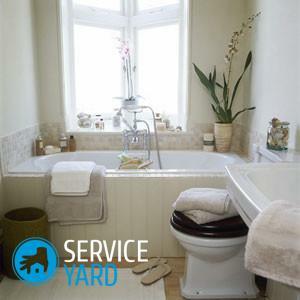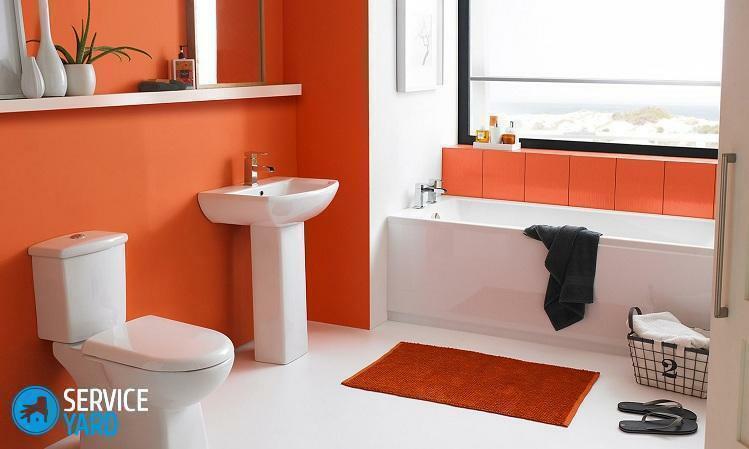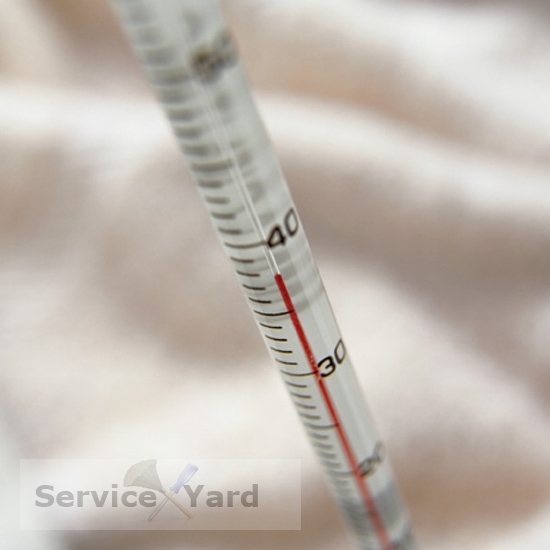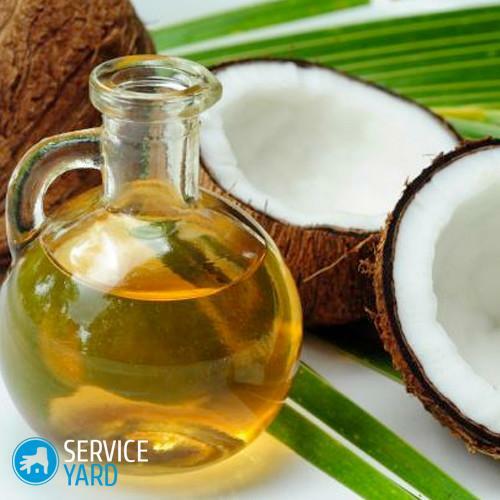
- Paint choice
- Water-based paint for walls - which is better?
- Glossy bathroom paints
- Matt paint for the bathroom
- How to remove old paint from the walls?
- Painting
Repair work in your own home is quite a costly process, but without a competent selection of a professional tool and building material, it will be difficult to implement them. Repair in the bathroom can be done very budget and look for a good alternative to tiling. Waterproof paint for a bathroom without a smell will not only save time, but also create an interesting design interior with the help of bright and saturated colors. In addition, by properly selecting the material, it is possible to achieve the durability of the repair. However, it is worth knowing what kind of paint for the bathroom will be the most optimal.
to the contents ↑Paint choice
The paint for the bathroom must be waterproof. In addition, it must have antibacterial protection, as in rooms with high humidity favorable conditions are created for the reproduction of microorganisms.
For premises with a high level of humidity, the following types of paint can be used:
- Water-based paint - is divided into acrylic, silicone, latex and with the addition of PVA.
- Chlorinated rubber - usually used in swimming pools, because it does not allow moisture to pass through.
- Alkyd Enamel - is a universal, which is used for outdoor activities and protection of metal surfaces from corrosion. Water resistant, quickly dries up due to oxidation with oxygen and forms a thin layer, which perfectly flows around all surface irregularities without divorces and traces. It has a rather unpleasant smell, therefore it is undesirable for use in residential premises.
- Oily - it was often used in the Soviet times for the decoration of bathrooms. Has an unpleasant smell and dries more than days. Its use is possible, if you do not have other means, however, it can quickly crack, and then it will be difficult to remove it from the wall.
Water-based paint for walls - which is better?
Let's take a closer look at which water-based paint is odorless for the walls in the bathroom best:
- The most popular are acrylic based paints. They have a low price and perfectly envelop the surface, and are also good for use in rooms with high humidity.
- Latex paint, unlike acrylic, after drying forms a film, which additionally protects it from dirt and moisture.
- Water based on PVA is the most budget option, it is inappropriate for bathrooms, only for ceilings in dry rooms.
- The most modern paint - on a silicone base, has a waterproof structure, is not afraid of moisture. As a rule, it is used for painting facades.
Important! After you decide which color to choose for the bathroom, you should choose the desired color. Usually in construction shops there are tinting machines that will help to obtain the desired shade with high accuracy. But also it can be done manually.
to content ↑Glossy bathroom paints
When choosing a bathroom paint, you should pay attention to the visual effect, which can be glossy or matte depending on the general interior of the room:
- Glossy coatings create a beautiful smooth surface and a mirror effect that oftenThey are used in small bathrooms for visual expansion of space.
- When deciding which paint to choose for the bathroom, it must also be remembered that the glossy surfaces are better washed, have greater elasticity.
Important! Before you start painting the walls of the bathroom with glossy paint, remember that such a finish coat requires an ideal smooth foundation, because the nominal gloss will emphasize all the irregularities of the wall. If the wall does not have a perfect surface, then it is better to use materials with a matte effect.
to the contents ↑Matt painted bathroom
Matte paint has no reflection effect, it excellently conceals small errors. In many cases, matte paint can be applied only one layer, which will be enough to overlap the color of the substrate.
The choice of paint for a bathroom with a matt base should be considered, because on such surfaces, dirt is very visible, and you can not remove them with a wet rag - you will have to repaint the damaged surface again.
Important! When choosing the type of surface it is necessary to take into account the area of its application: how often the surface will need cleaning, this will determine the type of coating.
to the contents ↑How to remove old paint from walls?
In order for your repair to be durable and the used coating to please the eye, it is advisable to use the recommendations for proper preparation of the wall surface before applying the selected water-resistant paint for the bathroom without a smell.
Required tools
There are many manuals on how to remove paint from the surface of the bathroom walls before applying odorless paint to the walls in the bathroom:
- Special chemical solvents to be used on the surface to be treated.
Important! All chemicals have a rich pungent odor, so you should refrain from treating small rooms or use special masks.
- Removing the old paint layer with a construction hair dryer or curling iron is a rather traumatic method of cleaning the walls. In addition, during the heating of the coating, a toxic vapor harmful to health will be formed.
- Electromechanical cleaning method using a grinder or a drill. On any of these instruments a special nozzle is put on, which will qualitatively remove the finish layer. For a good result, you need to select the brush of the desired stiffness, with which you will remove the existing amount of coating.
Important! This method is most effective for cleaning walls from old coating, but at the same time, it is the most noisy and leaves behind a large amount of dirt and dust.

Surface preparation technology
If you want the coating to hide unevenness, and the painting process does not take much time, you need to understand how to remove the old paint from the walls of the bathroom, in what ways it can be done. The main steps that include the entire cleaning process are as follows:
- Remove the previous coating layer with a flexible disk under the emery, scrapers, spatula or special solvents.
- Remove the dust that formed after removing the painting layer with warm water.
Important! Be sure to primetrutuyte walls and apply acrylic filler to eliminate defects - this will protect the surface from penetration of dirt and increase the long-term coverage.
- Use sandpaper and remove any irregularities.
- Use copper sulfate or bleach to eliminate fungi or mold, if any.
- Treat the walls with a latex primer in 3 layers.
Important! At each coat layer, it is necessary to wait for complete drying.
to the contents ↑Painting
After carefully prepared walls, the most interesting and responsible painting work was left. This process will entice anyone from the very first minute. But for a good result, use only the best paint for the bathroom.
Work Tips:
- It is desirable to apply the paint in 2 layers. The first part of the composition can be diluted with water. It should not be more than 15% of the total volume.
- Surplus should be removed from the tool so that they are not transferred to the wall. For these purposes, a tray with grooves is perfect. At its bottom poured paint, it moistened the roller, which is then rolled out along the grooves. Disregarding this recommendation, you will have to struggle all the time through dribbles, which can turn the creative process into exhausting work.
- In order for the paint not to fall on unnecessary areas, use paint tape. With its help, you can create smooth transitions of color from dark to light shade.
- Painting surfaces begin with corners and hard to reach areas. After this, the whole surface is finished. If there are irregularities, the first layer is better applied with a brush, then it will come out more dense.
- The second layer is applied with a roller. Do this after completely drying the first layer.
Important! Having bought a white paint with a color, it is necessary to mix it in large quantities, so that it will be enough for all the walls. If you have purchased several cans of finished color, then it is better to mix them in one container, because they may differ in tint. In the bank, you can not notice it, but the difference will be visible after the walls have dried.
Choosing a painting tool
Different types of tools can be used for painting walls: spray gun, roller, brush. A water-resistant paint for a bathroom without a smell will perfectly cover the walls from any of the listed tools, although each of them has its own peculiarities:
- Brush - it can densely cover the surface, however its use increases the paint consumption. Buy it can be in any store and at a small price.
- Roller - perfectly applies the composition to smooth surfaces. It distributes the paint well and very economically. However, to handle the angles and various irregularities, you still have to use the brush. For water-emulsion compounds, rollers made of felt are well suited.
Important! The width of the roller should be selected according to the area of the staining. The larger the area, the wider the roller.
- Pulverizer - most evenly and qualitatively causes the composition. However, in itself, it requires careful care. After each use, it must be thoroughly washed.
Important! With a single painting of a small area, it is better to do with a brush or roller. This will make it possible to save on tools. In addition, they are perfectly laundered from water-based paints and can be used in other jobs repeatedly.
Painting walls with water-resistant paint for a bathroom without a smell - inexpensive, fairly simple, but with it, an effective way to update the interior. Using quality materials and tools, and also carefully preparing the surface, you get the perfect result. Show your imagination and create a unique design!



